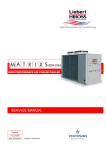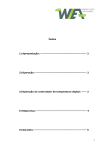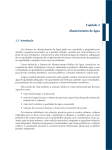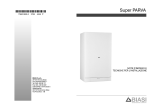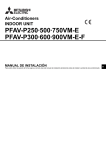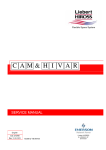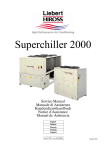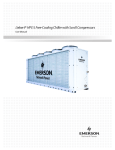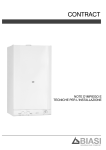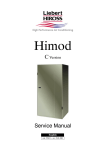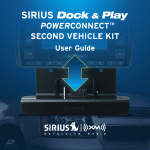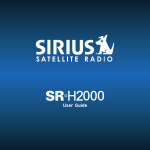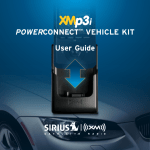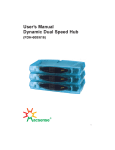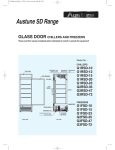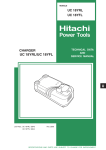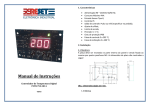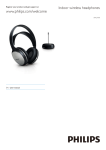Download SERVICE MANUAL
Transcript
S [017-032] HIGH PERFORMANCE AIR COOLED CHILLER SERVICE MANUAL English Cod. 272902 Rev. 25.05.2005 Issued by T.D.Service Caution It S S S is recommended that: the manual is retained for the entire service life of the machine; the user reads the manual carefully before carrying out any operations on the machine; the machine is used exclusively for the purpose for which it is intended; incorrect use of the machine shall release the manufacturer from any liability. This manual has been prepared to enable the end ---user to carry out only those operations that can be done with the panels closed. Any operations that require the opening of doors or equipment panels must be carried out only by qualified personnel. Each machine is equipped with an electric isolating device which allows the operator to work in conditions of safety. This device must always be used to eliminate risks during maintenance (electric shocks, scalds, automatic restarting, moving parts and remote control). The panel key supplied with the unit must be kept by the person responsible for maintenance. For identification of the unit (model and serial no.) in case of the necessity for assistance or spare parts, read the identification labels affixed to the outside and inside of the unit. IMPORTANT: This manual may be subject to modification; for complete and up ---to---date information the user should always consult the manual supplied with the machine. Index 1 -- 2 -- 3 -- 4 -- 5 -6 -7 -8 -- Introduction . . . . . . . . . . . . . . . . . . . . . . . . . . . . . . . . . . . . . . . . . . . . . . . . . . . . . . . . . . . . . . . . . . . . . . . . . . . . . . . 1 1.1 1.2 1.3 1.4 --------- Foreword . . . . . . . . . . . . . . . . . . . . . . . . . . . . . . . . . . . . . . . . . . . . . . . . . . . . . . . . . . . . . . . . . . . . . . . . . . . . . . . . . . . . Responsibility . . . . . . . . . . . . . . . . . . . . . . . . . . . . . . . . . . . . . . . . . . . . . . . . . . . . . . . . . . . . . . . . . . . . . . . . . . . . . . . . Inspection . . . . . . . . . . . . . . . . . . . . . . . . . . . . . . . . . . . . . . . . . . . . . . . . . . . . . . . . . . . . . . . . . . . . . . . . . . . . . . . . . . . General description . . . . . . . . . . . . . . . . . . . . . . . . . . . . . . . . . . . . . . . . . . . . . . . . . . . . . . . . . . . . . . . . . . . . . . . . . . . . 1 1 1 1 Preliminary Operations . . . . . . . . . . . . . . . . . . . . . . . . . . . . . . . . . . . . . . . . . . . . . . . . . . . . . . . . . . . . . . . . . . . . 1 2.1 2.2 2.3 2.4 2.5 ----------- Operating limits . . . . . . . . . . . . . . . . . . . . . . . . . . . . . . . . . . . . . . . . . . . . . . . . . . . . . . . . . . . . . . . . . . . . . . . . . . . . . . . Sound pressure levels . . . . . . . . . . . . . . . . . . . . . . . . . . . . . . . . . . . . . . . . . . . . . . . . . . . . . . . . . . . . . . . . . . . . . . . . . Transport . . . . . . . . . . . . . . . . . . . . . . . . . . . . . . . . . . . . . . . . . . . . . . . . . . . . . . . . . . . . . . . . . . . . . . . . . . . . . . . . . . . . Foundations . . . . . . . . . . . . . . . . . . . . . . . . . . . . . . . . . . . . . . . . . . . . . . . . . . . . . . . . . . . . . . . . . . . . . . . . . . . . . . . . . . Service area . . . . . . . . . . . . . . . . . . . . . . . . . . . . . . . . . . . . . . . . . . . . . . . . . . . . . . . . . . . . . . . . . . . . . . . . . . . . . . . . . . 1 1 2 2 2 Installation . . . . . . . . . . . . . . . . . . . . . . . . . . . . . . . . . . . . . . . . . . . . . . . . . . . . . . . . . . . . . . . . . . . . . . . . . . . . . . . . 2 3.1 --3.2 --3.3 --- Hydraulic connections . . . . . . . . . . . . . . . . . . . . . . . . . . . . . . . . . . . . . . . . . . . . . . . . . . . . . . . . . . . . . . . . . . . . . . . . . 2 Connection of the safety valve discharge . . . . . . . . . . . . . . . . . . . . . . . . . . . . . . . . . . . . . . . . . . . . . . . . . . . . . . . . . 3 Electrical connections . . . . . . . . . . . . . . . . . . . . . . . . . . . . . . . . . . . . . . . . . . . . . . . . . . . . . . . . . . . . . . . . . . . . . . . . . . 4 Start-- Up and Operation . . . . . . . . . . . . . . . . . . . . . . . . . . . . . . . . . . . . . . . . . . . . . . . . . . . . . . . . . . . . . . . . . . . 4 4.1 4.2 4.3 4.4 4.5 4.6 ------------- Initial check . . . . . . . . . . . . . . . . . . . . . . . . . . . . . . . . . . . . . . . . . . . . . . . . . . . . . . . . . . . . . . . . . . . . . . . . . . . . . . . . . . First start---up (or after a long stop) . . . . . . . . . . . . . . . . . . . . . . . . . . . . . . . . . . . . . . . . . . . . . . . . . . . . . . . . . . . . . . . Starting and stopping . . . . . . . . . . . . . . . . . . . . . . . . . . . . . . . . . . . . . . . . . . . . . . . . . . . . . . . . . . . . . . . . . . . . . . . . . . Chillers serving special plants . . . . . . . . . . . . . . . . . . . . . . . . . . . . . . . . . . . . . . . . . . . . . . . . . . . . . . . . . . . . . . . . . . . Freecooling . . . . . . . . . . . . . . . . . . . . . . . . . . . . . . . . . . . . . . . . . . . . . . . . . . . . . . . . . . . . . . . . . . . . . . . . . . . . . . . . . . Microprocessor control . . . . . . . . . . . . . . . . . . . . . . . . . . . . . . . . . . . . . . . . . . . . . . . . . . . . . . . . . . . . . . . . . . . . . . . . . 4 5 5 5 5 5 Refrigerant and Oil Charge . . . . . . . . . . . . . . . . . . . . . . . . . . . . . . . . . . . . . . . . . . . . . . . . . . . . . . . . . . . . . . . . . 5 5.1 --5.2 --- Refrigerant charge . . . . . . . . . . . . . . . . . . . . . . . . . . . . . . . . . . . . . . . . . . . . . . . . . . . . . . . . . . . . . . . . . . . . . . . . . . . . 5 Oil charge . . . . . . . . . . . . . . . . . . . . . . . . . . . . . . . . . . . . . . . . . . . . . . . . . . . . . . . . . . . . . . . . . . . . . . . . . . . . . . . . . . . 5 Safety Devices Settings . . . . . . . . . . . . . . . . . . . . . . . . . . . . . . . . . . . . . . . . . . . . . . . . . . . . . . . . . . . . . . . . . . . . 6 6.1 --- Setting thermostatic expansion valve . . . . . . . . . . . . . . . . . . . . . . . . . . . . . . . . . . . . . . . . . . . . . . . . . . . . . . . . . . . . . 6 Maintenance . . . . . . . . . . . . . . . . . . . . . . . . . . . . . . . . . . . . . . . . . . . . . . . . . . . . . . . . . . . . . . . . . . . . . . . . . . . . . . 7 7.1 --7.2 --- Spare parts . . . . . . . . . . . . . . . . . . . . . . . . . . . . . . . . . . . . . . . . . . . . . . . . . . . . . . . . . . . . . . . . . . . . . . . . . . . . . . . . . . 7 Dismantling the unit . . . . . . . . . . . . . . . . . . . . . . . . . . . . . . . . . . . . . . . . . . . . . . . . . . . . . . . . . . . . . . . . . . . . . . . . . . . 7 Options and Accessories . . . . . . . . . . . . . . . . . . . . . . . . . . . . . . . . . . . . . . . . . . . . . . . . . . . . . . . . . . . . . . . . . . . 7 8.1 8.2 8.3 8.4 8.5 ----------- Pump set . . . . . . . . . . . . . . . . . . . . . . . . . . . . . . . . . . . . . . . . . . . . . . . . . . . . . . . . . . . . . . . . . . . . . . . . . . . . . . . . . . . . Water chiller with partial heat recovery (20%) . . . . . . . . . . . . . . . . . . . . . . . . . . . . . . . . . . . . . . . . . . . . . . . . . . . . . . Water chiller with total heat recovery (100%) . . . . . . . . . . . . . . . . . . . . . . . . . . . . . . . . . . . . . . . . . . . . . . . . . . . . . . . Hydraulic circuit accessories . . . . . . . . . . . . . . . . . . . . . . . . . . . . . . . . . . . . . . . . . . . . . . . . . . . . . . . . . . . . . . . . . . . . Water chiller with inertia tank . . . . . . . . . . . . . . . . . . . . . . . . . . . . . . . . . . . . . . . . . . . . . . . . . . . . . . . . . . . . . . . . . . . . 7 7 8 8 8 Tables . . . . . . . . . . . . . . . . . . . . . . . . . . . . . . . . . . . . . . . . . . . . . . . . . . . . . . . . . . . . . . . . . . . . . . . . . . . . . . . . . . . . . . . . . . 9 Drawings . . . . . . . . . . . . . . . . . . . . . . . . . . . . . . . . . . . . . . . . . . . . . . . . . . . . . . . . . . . . . . . . . . . . . . . . . . . . . . . . . . . . . . 15 Circuits . . . . . . . . . . . . . . . . . . . . . . . . . . . . . . . . . . . . . . . . . . . . . . . . . . . . . . . . . . . . . . . . . . . . . . . . . . . . . . . . . . . . . . . . 23 1 --- Introduction try, and includes all the components necessary for automatic and efficient operation. Each unit is completely factory assembled; after evacuation, the necessary quantity of refrigerant is added to the refrigerant circuit(s) and the unit is tested. All the units are equipped with one or two independent refrigerating circuits, each one composed of: an air cooled condenser, a hermetic Scroll compressors and a braze ---welded plate evaporator. The components of the liquid line are the charging valves, filters dryers, solenoid valve, shut---off valve, moisture indicator and thermostatic expansion valve. The hydraulic circuit --- with max. working pressure 5 bar --- is made up of carbon steel pipes connected with grooved ---end (Victaulic) fittings and couplings and include also a flow switch (optional) and, in the freecooling versions, chilled water coils and a three ---way valve. The hermetic scroll compressors are complete with the following protection/safety devices: oil heater, electronic protection monitoring the temperature of the motor windings and the direction of rotation (the latter may be enclosed in the electronics of the compressor or external, depending on the model). The ”MATRIX S” water chillers are controlled by the ”MICROFACE” microprocessor, managing all the unit operating conditions. The user can change and/or modify the operating parameters through the display keyboard installed on the electrical panel. The electrical control board is equipped with all the safety and operating devices required for reliable operation. The compressor motors are equipped with protection on all three phases and are started by three ---pole contactors. 1.1 --- Foreword This handbook is aimed at enabling both the installer and the operator to carry out the correct installation, operation and maintenance of the refrigerating machine, without damaging it or causing injuries to the relevant staff. The handbook is thus an aid for the qualified staff in the arrangement of the specific equipment for the correct installation, operation and maintenance in compliance with the local regulations in force. The MATRIX S [017 ---032] water chillers can be identified as follows: CBH023 Cooling Capacity “kW” Nominal cooling capacity x 10 Compressor: H Hermetic Scroll Version: B Base L Low Noise Q Quiet 2 --- Preliminary Operations 2.1 --- Operating limits The units can operate within the indicated operating ranges (see Tab. 7). These limits apply to new machines, subject to correct installation and maintenance. S Ambient air minimum temperature: ---25ûC for Superchiller, +15ûC for Chiller without fan speed control (Operation allowed only in summer mode), ---10ûC for Chiller with continuous fan speed control (Either Triac or EC fan); S Maximum outdoor air temperature is in relation to each model, as indicated in Tab. 7. In any case outdoor temperatures aver 45ûC are not admitted; such limits are determined by electrical and electronic components fitted on units; S Maximum water flow allowed: depending on the pressure drop corresponding to the required thermal difference (usually not lower than 3.5ûC --- 4ûC); S Minimum allowed water flow: compatible with a sufficient evaporation temperature, to avoid the intervention of the safety devices (to be evaluated for a thermal difference not higher than 8ûC); S Temperature range of the water exiting the evaporator: 4ûC --- 15ûC; S Maximum temperature of the water entering the unit: 20ûC; higher temperatures are allowed only at the system start--up and not during normal operation; S Maximum glycol concentration: 50% (35% with the optional pump assembly installed on the machine); S Minimum allowed glycol concentration: depending on the minimum temperature of the ambient air expected at the installation site (see Tab. a); S Maximum pressure of the hydraulic circuit: 5 bar; S Voltage range for the electric supply: 400 V +/ --- 10%; max. phase difference: 3%; tolerance on frequency: 1%. Storage conditions: from ---20ûC to 45ûC for all MATRIX S models Note: Avoid positioning in areas with strong dominant winds that may impair the operation and effect the indicated limits. Execution: C Chiller S Superchiller 1.2 --- Responsibility Liebert Hiross accepts no present or future responsibility for damage to persons, things or to the machine itself due to operators’ negligence, failing to comply with the installation, operation and maintenance instructions of this handbook, failed application of the safety norms in force for the system and the qualified staff charged with the operation and maintenance. 1.3 --- Inspection All units are fully assembled and wired in the manufacturing plant. Before shipment they are charged with the necessary quantities of refrigerant and oil and then tested at the operating conditions normally required by the customer. The machine’s hydraulic circuit is equipped with drain plugs and open vent valves; the freecooling coils are supplied dry to avoid possible problems due to frost in the storage period. Immediately inspect the machine carefully on delivery to check for damage during transportation or missing components; possible claims must be made immediately to the carrier and the factory or its representative. 1.4 --- General description MATRIX S units with air cooled condensers have been designed and manufactured for producing chilled water. They are also available in versions with a built---in freecooling module, in versions with heat recovery for simultaneous heating of thermal circuit water, with a pump assembly installed on the machine and/or inertial buffer tank inside the machine; the chilling units can be equipped with several options indicated in the price list. The ”MATRIX S” product line has been designed utilising the state ---of ---the ---art techniques available nowadays in the indus- 1 2.2 --- Sound pressure levels 7) Place a mesh filter at the inlets of the pump and water chiller (Can be supplied as an optional accessory ---Not fitted); 8) Install, at the highest points in the circuit, apparatus which allows the bleeding of air and possibly the filling of glycol; 9) Place a drain valve at the lowest point in the circuit and immediately at the outlet of the water chiller; 10) Install a water filling set including the following: a) filling water meter; b) manometer; c) non ---return valve; d) air separator; e) removable supply tube, which must be disconnected after each charge/top ---up; 11) For maximum protection ensure that all tubing exposed to low outdoor temperatures is fitted with anti ---freeze heaters and insulated using closed cell synthetic rubber (elastomer); 12) The circuit must include an expansion vessel (with safety valve) of suitable capacity; 13) Connect the lines avoiding stresses on the machine inner parts. Note: If the water chiller is complete with an expansion vessel (supplied as an option), check if the capacity is enough, and install a second vessel in the circuit, if required (see par. 8.4). Follow the indications in Fig. c for the correct sizing. Note: The whole circuit must contain a water volume suitable for the capacity of the installed chiller. Check if the inertial capacity given by the sum of the hydraulic volume inside the machine (including the volume of the optional interna tank, if fitted) and the system volume is sufficient, or possibly install a tank in the circuit. Follow the indications in Fig. b for the correct sizing. Note: The hydraulic circuit must ensure a constant water supply to the evaporator in every operating condition. Otherwise, the compressors may be damaged by repeated returns of liquid refrigerant on their suction. Note: The water flow switch is a compulsory safety component that must be installed and correctly wired to the Matrix S chillers, otherwise the guarantee will be invalidated. It is installed, as standard, on units with the optional on ---board pump set, and is available as a option for units without pumps on board: in the latter case the flow switch, if not installed on the machine, can be installed on the hydraulic circuit by the installer, but it is compulsory that it is wired to the electric panel terminal board, as indicated on the wiring diagram. The Tab. 4 shows the noise data for the units in standard configuration (without pumps), operating continuously and measured according to the ISO 3744 norm, in free field conditions. The highest noise levels are detected on the condenser coil side. Note: Avoid positioning in areas with possible reverberation of the sound waves, which can adversely effect the noise levels. 2.3 --- Transport Handle the unit by lifting it with a crane from above; The lifting holes are positioned in the frame’s base (when lifting, use spreader bars to protect the sides, see Fig. 2). Note: Place the lifting tubes in the holes in the base indicated by ”LIFT HERE”. Lock the ends of the tubes with the locking pins and splits pins as shown in Fig. 2. The capacity of the lifting gear must be adequate to lift the load in question. Check the weight of the units, the capacity of the lifting gear and ropes and the condition and suitability of the aforementioned equipment. S S 2.4 --- Foundations The unit must be placed on a level surface which will support its weight. S If necessary, position the unit on suitable anti ---vibration supports that can be supplied as an option (in rubber or spring --type). Refer to the manual ”Installation of the spring anti --vibration supports” for their correct positioning. S When positioned, level the unit. Note: For weight distribution see Fig. 3. Note: The weights and their distribution refer to standard units without options; if the pump assembly, or other options are installed on the machine, add the weights of the installed accessories to those of the standard units (see Tab. 8). S 2.5 --- Service area S S S In order to allow free air flow and maintenance of the unit, a minimum area must be left free of obstructions around the unit (see Fig. 1). The hot air expelled by the fans must be allowed to rise unimpeded by obstacles for a minimum height of 2.5 m. Avoid recirculation of hot air between the suction and discharge, otherwise the unit performance may be impaired or the standard operation can be interrupted. 3.1.2 -- Addition of water and ethylene glycol 3 --- Installation Very important: Add water and ethylene glycol to the circuit with a % depending on the minimum temperature of the outside air expected at the installation site. Do not exceed the nominal operating pressure of the circuit’s components. Notes: S To avoid stratification run the circulation pump for at least 30 minutes after adding any glycol. S After adding water to the hydraulic circuit always disconnect the water supply coming from the sanitary supply; this avoids the danger of glycol entering the sanitary water system. S After any topping ---up of the water check the concentration and add glycol if necessary. 3.1 --- Hydraulic connections 3.1.1 -- Hydraulic circuit construction (Fig. a) The piping must be connected to the chiller. Construct a chilled water circuit as described below, see Fig. a: 1) Place shut---off valves within the circuit to allow servicing; 2) Install a pump system suitable for the flow rate required at a pressure head equal to the sum of all the pressure drops (see project data). Matrix S chillers can be equipped, upon request, with pumps having performance as indicated in Tab. 8; 3) Install manometers at the chiller inlet/outlet; 4) Install thermometers at the chiller inlet/outlet; 5) Connect the pipes to the chiller by flexible joints to avoid transmitting vibrations and to balance the thermal expansion; proceed in the same way even if the pump set is outside the chiller; 6) It is useful to include a water pressure switch to give an early warning of low water pressure; 3.1.3 -- Water-- glycol mixture Water ---glycol mixtures are used as the thermal carrier fluid in very cold climates or with temperatures below zero degrees centigrade. Determine the ethylene glycol % which must be added to the water, with the assistance of Tab. a. 2 Tab. a -- Ethylene glycol to be added to water (% in weight of total mixture) Ethylene glycol (% in weight) 0 10 20 30 40 50 Freezing temperature, ûC (*) 0 ---4.4 ---9.9 ---16.6 ---25.2 ---37.2 Mixture density at 20ûC (*), kg/l --- 1.017 1.033 1.048 1.064 1.080 ALWAYS CHARGE THE HYDRAULIC CIRCUIT WITH THE REQUIRED GLYCOL % NECESSARY FOR THE MINIMUM AMBIENT TEMPERATURE AT THE INSTALLATION SITE. FAILING TO COMPLY WITH THIS INSTRUCTION SHALL INVALIDATE THE UNIT WARRANTY. 3.2 --- Connection of the safety valve discharge Safety valves are installed on the high pressure side of the refrigeration circuit: the discharge of these valves must be conveyed outside through a suitable pipe, having a diameter of at least that of the valve outlet, without burdening the valve body. Convey the discharge to areas where the jet cannot harm people and the surrounding environment. (*) Values are for Shell antifreeze 402. For different brands, check manufacturer’s data. For the chiller internal water volume refer to Tab. 1. If the optional buffer tank is installed on the machine, add the tank hydraulic volume. Fig. a -- Ideal chilled water circuit 1 6 3 4 7 2 5 3 4 1 8 T T CHILLER 5 disconnect after charge 5 9 flow Vpt Tank USER 9 10a 10b 10c 10d 10e 1 1 11 12 Fig. b -- Inertia tank sizing The total optimum hydraulic volume of the system where the Matrix S chiller is installed can be calculated by the following formula: V= 43 x Rt Xd where: --- V=minimum required total water volume expressed in litres --- Rt=refrigeration capacity expressed in kW --- Xd=differential band set on the control and expressed in degrees centigrade Please note that the sum of the hydraulic volume of the Matrix S chiller (Vm) plus the volume of the hydraulic circuit connected to it (Vpc) must be greater than, or equal to the minimum required total water volume (V). If this condition is not satisfied, it is necessary to install an inertia tank (Vpt, as indicated in the Fig. a) with a volume at least equal to the following value: Vpt=V ---Vm ---Vpc 3 Fig. c -- Sizing of the expansion vessel The total volume of the expansion vessel is calculated with the following formula: V= Cxe Pi 1 -Pf where: --- C=quantity of water inside the system expressed in litres --- e=water expansion coefficient, with water at 10ûC as a reference --- Pi=absolute pressure of initial charging, equivalent to the vessel pre ---charge pressure (typical value 2.5 bara) --- Pf=absolute final tolerated pressure, lower than the operating pressure of the safety valve calibration pressure (typical value 4.0 bara). Use the values of the water expansion coefficient indicated in the table below: H2O T [°C] Density [kg/m3] 10 999.6 --- --- --- 20 997.9 0.0017 30 995.6 0.0040 40 992.2 0.0075 50 988.1 0.0116 Expansion coefficient “e” 3.3 --- Electrical connections Operate (open) the main switch before carrying out any maintenance work on electrical components. Note: It is forbidden to work on the electrical components without using insulating platforms, and in the presence of water or fog or mist. Note: The supply to the external pump assembly must be made before starting the chiller and must be kept on as long as the chiller is in use. Incorrect operation will cause the unit to lock ---out because of the internal protections (flow switch intervention). Note: The compressors are equipped with an electronic protection device blocking their start if the phase sequence is not correct, or stopping their operation if a thermal relay intervenes. This device is essential for the integrity of the mechanical and electrical components of the compressors. Reset the standard functions by isolating this device and removing the causes of the lock ---out. Note: The chillers are equipped with their own microprocessor control adjustment. The use of the remote ON ---OFF input (located in the electric panel terminal board) as a system temperature control element is forbidden. 1) Before proceeding with the electrical connections, ensure that: S all electrical components are undamaged; S all terminal screws are tight; S the supply voltage and frequency are in accordance with the rating (with tolerance in accordance with IEC 8---6 norms, March 1990) S the allowed phase to phase variability is 3% maximum (see Fig. d). Variability in excess of 3% invalidates the guarantee. 2) Supply cable connections (see Tab. 6): S Connect the cable to the supply terminals. S Use appropriately sized 3---pole cable. An earth wire must also be connected. S After having opened the passage in the framework (pre --punched knock ---outs) for the supply line entry, restore the original degree of protection using suitable accessories for the wiring and junction boxes. Fig. d -- Example of calculating phase to phase variability 1) The 400 V supply has the following variability: RS = 388 V ST = 401 V RT = 402 V R S T 4 --- Start---Up and Operation 4.1 --- Initial check 1) Check all water connections. 2) Open the shut---off valve on the liquid line. 3) Ensure that the intake pressure is higher than 4.0 bar; if this is not the case, prolong pre ---heating of the compressor (if possible) and check that the refrigerant shut---off valve is properly sealed, see Fig. 9. 4) Open all isolating valves and/or water ball valves. 5) In case of climates with temperatures below zero degrees C, make sure the chilled water circuit is filled with the correct concentration of water/glycol. 6) Bleed all air out of the chilled water circuit. 7) Verify the water flow rate and its direction. 8) Ensure that the thermal load is sufficient for start---up. Caution: The ambient air temperature probe must be positioned in the shade and protected against the weather. 2) The average voltage is: 388 + 401 + 402 = 397 3 3) The maximum deviation from the average is: 402 --- 397 = 5 V 4) The phase to phase variability is: 5 x 100 = 1.26 (acceptable) 397 Note: The power supply should never be disconnected, except when performing maintenance. 4 4.2 --- First start ---up 5 --- Refrigerant and Oil Charge Operate as follows: 1) At least 8 hours before the start ---up, power the crankcase heaters by setting the main isolator switch ON. Make sure the auxiliary circuit has been powered and check the operation (a fault due to an incorrect procedure will invalidate the compressor guarantee). 2) Open the valves of the refrigeration circuit that had been closed before the initial check. 3) Check the machinery supplying the thermal load connected with the unit and start the system pump(s). 4) MAKE SURE THE COMPRESSOR OIL HAS BEEN HEATED FOR AT LEAST 8 HOURS; start the unit only then. 5) Make sure the fans rotate in the correct direction (anticlockwise): check the electrical connections, if necessary. 6) Make sure the pumps rotate in the correct direction. 7) During the unit start ---up an inlet water temperature higher than 20ûC is allowed. Under standard operating conditions check that the limits indicated in paragraph 2.1 are not exceeded. 8) Check the correct operation of the control and safety devices. 9) Check the outlet temperature of the chilled water (check if the set---point set on the controller is reached). 10) Check the oil level in both compressors. 11) With the compressors at full load, check there are no bubbles visible in the frefrigerant sight glass. If there are any, charge the unit according to par. 5. All work on pipes or components of the refrigerating circuit under pressure must be exclusively carried out by qualified staff, competent in such works. (or after a long stop) 5.1 --- Refrigerant charge WHILST REPAIRING THE REFRIGERATING CIRCUIT RECOVER ALL THE REFRIGERANT IN A CONTAINER: DO NOT ALLOW IT TO ESCAPE. NEVER USE THE COMPRESSOR FOR THE SYSTEM VACUUM (THIS INVALIDATES THE WARRANTY). S The unit is delivered charged according to the Tab. 5. Warning for the refrigerant charge: S Ensure there are no refrigerant leaks. S Check the refrigerant type in the refrigeration circuit: a unit originally charged by the manufacturer with R407C cannot be charged with R22 and vice versa; possibly apply to the Technical Support Department. S Charge with the compressor in operation, connecting the cylinder with the charge connector after the thermostatic expansion valve. Flush the connection pipe between the cylinder and the charging point; tighten the seal joint and then start charging the unit. It is imperative that the cylinder is weighed both before and after the operation. S For the units with R407C the refrigerant charge must be made exclusively with liquid refrigerant. S Charge the unit until the bubbles in the sight glass have disappeared and the working conditions of the entire refrigeration circuit have returned to normal (sub ---cooling and superheating within the limits indicated below). S Measure the superheating as follows: 1) Detect the temperature on the suction line, close to the bulb of the thermostatic expansion valve, using a contact thermometer. 2) Connect a pressure gauge (by max. a 30---cm pipe) with the Schraeder connection and read the corresponding saturated evaporating temperature. 3) The superheating is the difference between the two readings. 4) For the units with R407C refer to the pressure gauge scale indicated with the initials D.P. (Dew Point) S Verify that the superheating is 5ûC --- 8ûC. S Measure the sub ---cooling as follows: 1) Detect the temperature on the liquid line using a contact thermometer. 2) Connect a pressure gauge (by max. a 30---cm pipe) with the Schraeder connection on the liquid line and read the corresponding saturated condensing temperature. 3) The sub ---cooling is the difference between the two readings. 4) For the units with R407C refer to the pressure gauge scale indicated with the initials B.P. (Bubble Point) S Verify that at the condenser outlet, sub ---cooling is 3ûC --5ûC. IT IS IMPORTANT TO CARRY OUT CHARGING CORRECTLY. An excess of refrigerant causes an increase in sub ---cooling and consequent operating difficulties in the hot season; a shortage of charge generates an increase in superheating and possible compressor stoppages. Whenever work is carried out on the unit, ensure afterwards that the working conditions are correct, checking sub ---cooling and superheating. 4.3 --- Starting and stopping ALWAYS ENSURE THAT THE COMPRESSOR OIL HAS BEEN PREHEATED. FOR BRIEF STOPPAGES MAINTAIN THE SUPPLY TO THE CRANKCASE HEATER. S Start the unit setting the Microprocessor switch ON. S Stop the unit setting the Microprocessor switch OFF. S In case of long stops, turn the machine off using the Microprocessor switch OFF. In this case the compressor crankcase heaters remain powered. S For seasonal shutdown of the unit operate the main switch located on the main electrical power supply. This will disconnect the compressor crankcase heaters. 4.4 --- Chillers serving special plants The units are capable of cooling a water ---glycol mixture to temperatures close to 0ûC without the need for significant modifications. In the case of modification, the set values of the safety and control components must also be changed. This can be carried out in the factory (at the time of testing) or at the time of installation, only by qualified and authorised personnel. 4.5 --- Freecooling The “freecooling” is a system of pre ---cooling and/or cooling the water/glycol mixture using ambient air when the latter is at a temperature below the return mixture temperature. If the outside temperature is sufficiently low to dissipate the entire heat load, the refrigeration compressors automatically switch off, and the mixture’s temperature is controlled by the fan speed adjustment. If the mixture temperature is too high for freecooling, the compressors will operate as long as necessary to ensure the correct water/glycol mixture temperature. 5.2 --- Oil charge 4.6 --- Microprocessor control Contact the Technical Support Department for the specifications of the oil to be used for topping up; the oil changes according to the type of used refrigerant. NEVER MIX DIFFERENT OILS TOGETHER. CLEAN THE PIPING COMPLETELY BEFORE CHANGING THE TYPE OF OIL USED. Consult the ”Microface and Hiromatic” Service Manual. 5 TOP---UPS OF UP TO 20---30% OF THE TOTAL AMOUNT OF OIL CONTAINED IN THE COMPRESSOR CRANKCASE ARE PERMITTED; FOR LARGER PERCENTAGES CONTACT THE TECHNICAL SUPPORT DEPARTMENT. 3) Connect to the fittings on the compressor body (Schraeder valves) and empty it of refrigerant until atmospheric pressure (1 bar) is reached. 4) Using a pipe, connect the oil container to the oil service fitting on the lower part of the compressor. 5) Open the oil service cock, lifting the container, so that the oil flows by gravity. 6) Charge the required quantity of oil (make sure the tube always remains below the oil level in the container). 7) Stop the oil flow by closing the oil service fitting, open the shut---off cock on the refrigerating circuit and restore the drained refrigerant charge. 5.2.1 -- Procedure for oil topping -- up If there has been any loss of oil then this must be topped up as follows: 1) Take a clean, dry, transparent container (with volume calibrations) and fill it with at least twice the amount of oil required. 2) Isolate the compressor by closing the cock on the liquid line. 6 --- Safety Devices Settings The water chiller has already been tested and set up by the manufacturer. The following setting values are suggested in the field. COMPONENT SETTING NOTES set diff. Operation with R407C/R22 (standard factory setting): Low pressure switch (LP) START DIFF. STOP 0.2 1.5 0.5 5 bar : 3.6 bar : 0.8 bar : 2.8 bar bar Operation with R407C/R22 (standard factory setting): High pressure switch (HP) STOP START DIFF. : 26 bar : 20 bar : 6 bar (fixed) reset The settings for the safety valves installed on the machine are indicated below: MODELS SETTINGS SAFETY VALVE CBH/CLH/CQH 017---020---023---025---028 SBH/SLH 017---020---023---025---028 SQH 017---020---023---025 29 bar high pressure side 6.1 --- Setting thermostatic expansion valve a) Remove the protective cover; b) Turn the adjustment screw to return to the optimum values, tightening it in a clockwise direction to increase the superheating, or slackening it to reduce the superheating. c) Wait about 10 minutes; d) Measure the superheating and repeat the operation if necessary. N.B: If the superheating is too low, there is a risk of poor lubrication and consequent breakage of the compressor as a result of pressure shock. If the superheating is too high the output of the system is limited and the compressor overheats. THIS OPERATION MUST BE PERFORMED BY AN EXPERIENCED REFRIGERATION TECHNICIAN. Before beginning this adjustment be sure that the refrigerant charge is correct, checking the the sub ---cooling (3ûC --- 5ûC, as specified in par. 5.1). The valve has already been factory ---set and should be reset when the superheating is not between 5ûC --- 8ûC, as follows: 1) Important: Ensure that the instructions in par. 5.1 have been carried out. 2) Allow the compressor to operate for 15 mins. 3) Measure the superheating as follows: a) Connect a manometer to the Schraeder connection located on the evaporator outlet tube, and read the manometric temperature on the scale for the refrigerant used (for the units with R407C refer to the pressure gauge scale indicated with the initials D.P. = Dew Point). b) Using a contact thermometer, measure the temperature on the tube coming out of the evaporator, next to the socket used for the manometer. c) The superheating is the difference between the two readings (b ---a). 4) The superheating must be 5ûC --- 8ûC; if not, set the expansion valve as follows: 6 7 --- Maintenance 7.1 --- Spare parts The use of original spare parts is recommended. When placing an order refer to the ”Component List” enclosed with the machine and quote the unit model no. and serial no. The Maintenance Programme below must be carried out by a qualified technician, preferably working under a maintenance contract. Before any intervention on the unit or accessing the inner components (removing the outer panels), always ensure the machine is switched off. If the front upper panels are removed (coil compartment) wait for the fan(s) to come to a complete stop before accessing the compartment; if the front lower panels are removed, pay special attention when working near the compressor upper part and the discharge line: they are very hot; possibly wait for them to cool. Be very careful when operating close to the finned coils, as the fins are very sharp. Do not remove the fan protection grille before electrically isolating the whole machine. Do not insert foreign matter through the fan protection grille. After the maintenance interventions, always close the unit with the suitable panels, fastened by the tightening system. 7.2 --- Dismantling the unit The machine has been designed and built to ensure continuous operation. The working life of some of the main components, such as the fans and the compressors, depends on the maintenance that they receive. If the unit has to be dismantled, the job must be done by skilled refrigeration technicians. The refrigerant and the lubricating oil in the circuit must be disposed of in conformity with the laws in force in your country. Maintenance programme -- Monthly check FANS S S Check that the fan motor rotates freely without any abnormal noise, and ensure that the bearings are not running hot. Also check the current absorption. S Check the conditions of the filters (if they are supplied); if necessary clean them (including the electrical panel ventilation filter). Check the condenser coils and clean if necessary with compressed air or soft brushes. CONTROL S Check that the control equipment, LEDs and display are operating correctly. ELECTRICAL CIRCUIT S S Check the electrical supply on all phases. Ensure that all electrical connections are tight. S Check the condensing and the evaporating pressures (to be done by a refrigeration technician). Check the compressor’s current absorption, the delivery temperature and possible unusual noises. Check the refrigerant charge by means of the sight glass. Check that the safety devices operate correctly. Check the correct operation of the thermostatic valve (superheating between 5ûC --- 8ûC). Check that the oil level indicated by the compressor sight glass is higher than the min. value. CONDENSER AND AIR FILTER S S REFRIGERATION CIRCUIT S S S S CHILLED WATER CIRCUIT S S S S S S S Ensure that there are no water leaks. Bleed any air out of the hydraulic circuit using the bleed valves. Verify that the water flow rate is correct. Check the inlet --- outlet liquid temperature and pressure. Check the correct operation of the three--- way valve (Versions with free--- cooling only). Check if the system is charged with the specified glycol percentage and that no ice has formed in the hydraulic circuit. Check the evaporator cleanliness. 8 --- Options and Accessories 8.1 --- Pump set uid through the duct of the air vent screw ensures lubrication and cooling of the shaft seal. Between the outlets of the two chambers and the discharge flange, twin ---head pumps have a non ---return flap valve in EPDM rubber. The flap is opened by the flow of the pumped liquid and cuts off the port of the idle pump chamber. In the electrical panel there are automatic circuit breakers for each pump; the microprocessor control manages the operating rotation between the two pumps and start---up of the stand ---by pump if the primary pump fails. For the technical features of the pumps and the hydraulic schematic see Tab. 8, Fig. 10 and Fig. 11. The centrifugal pump units are direct driven, with close --coupled motors and a single shaft; the induction motor has 2 poles with IP 55 protection and class F insulation. Pump casings and impellers are in cast iron EN ---GJL 200, shafts are in stainless steel, the shaft seal is a unbalanced, mechanical shaft seal with dimensions according to DIN 24 960 and assembly length according to EN 12 756, brass neck ring permits ideal conditions for the use of water mixtures containing ethylene glycol. The pump housing, the motor stool and the motor stator housing are electrocoated. The pump units have been chosen and sized to operate within specific limits, namely: S Water / ethylene glycol mixtures up to 65% / 35% by weight; S Temperatures of the standard pumped fluid not lower than 4°C. The motor stool forms connection between the pump housing and the motor, and is equipped with a manual air vent screw for venting of the pump housing and the shaft seal chamber. It is very important to carry out this operation as the circulation of liq- 8.2 --- Water chiller with partial heat recovery (20%) This option enables the recovery of up to 20% of the heat normally rejected by the condensers (see Tab. 2). The system does not require any adjustment and is made up of plate heat exchangers installed on each circuit before the condenser. The exchangers are protected by a suitable anti ---frost heater that operates when 7 8.5 --- Water chiller with inertia tank the system is stopped. It is recommended that a safety valve be installed in the hydraulic circuit to avoid hazards due to overpressures, if there is no water flow through the recuperator. The water temperature at the recuperator inlet (in stable operating conditions) must be in the range of 25ûC --- 45ûC, with an outlet differential of between 3.5ûC --- 8ûC. The machine can be supplied complete with a buffer tank; it performs the inertial stabilizer function, for a better compressor operation, summed up in the following two points: S it reduces the frequency of the compressor start up and consequent high current peaks, which is higher when the system thermal inertia is lower, improving their performance. S it naturally eliminates the operation troubles caused by sudden load variations (shown by variations of the chilled water temperature). The buffer tank is supplied complete with manometer and temperature sensor well, air purge valve, discharge valve and sinking connection for electric heaters; max operating pressure: 6 bar. Built in carbon steel and coated with anti ---condensate insulation with PVC film proper for outdoor installation. It is installed inside a cabinet which can be supplied either already connected to the unit (mechanically and hydraulically jointed to it) or loose (completely separate from the unit). 8.3 --- Water chiller with total heat recovery (100%) All heat discharged by the unit to the condenser is recovered (see Tab. 3). The system includes an additional refrigerating circuit made up of 2 two---way solenoid valves, supplying --- in case of hot water demand --- a plate exchanger, usually by ---passed and sized so as to discharge all condensing heat (also installed before the finned air condenser in series with it); a check valve, a liquid receiver at the exit of the finned air condenser working as storage for the needed additional refrigerant charge (see refrigerating scheme). The recuperator is insulated with closed cell polyurethane and is equipped with heaters activated when the recuperator is deactivated to prevent frost in winter with the system stopped or not perfectly drained. The operation in total recovery mode is enabled by an external contact. The Microface control will simultaneously suit the fan speed changing the fan speed setpoint differently from the standard operation without recovery (practically slowing the fans down till they switch off); anyway, the operation in recovery mode is enabled also without load at the users. Indeed, if the users do not demand heat, the water flowing to the condenser reaches a temperature that does not enable the total condensation of the compressed gas, and the remaining portion of the phase change can thus take place in finned coil without interrupting the recovery process through the intervention of the machine safety devices. If the plate exchanger is supplied with too cold water, or if the system is not preset by the installation technician with a three or two---way proportional adjustment valve for the exchanger bypass (indispensable for cold starts, see following “Recommended hydraulic circuit” ), the condensing pressure tends to decrease too much; a prolonged condition of low condensing temperature below the safety threshold leads the Microface microprocessor control to disable the heat recovery, protecting the system from any possible malfunctioning. Technical data: S Internal volume: S Net weight: S Working weight: Fig. e -- Recommended hydraulic circuit Heat recovery users Heat recovery exchanger 8.4 --- Hydraulic circuit accessories Made up of an expansion vessel (pre ---charged at 1.5 bar, max. operating pressure 10 bar) and a safety valve, set at 5 bar. Their position in the hydraulic circuit is illustrated in Fig. 10, Fig. 11. S Expansion vessel volume: 12 litres for all units. It is recommended that the total required expansion vessel capacity is always checked, depending on the unit’s internal hydraulic volume (with the volume of the buffer tank, if installed), the user circuit volume, the glycol percentage in the mixture, and the expected maximum temperature variation of the mixture. The water flow switch is a compulsory device protecting the unit. It is installed, as standard, on units with the optional on ---board pump set, and is available as a option for units without pumps on board: in the latter case the flow switch, if not installed on the machine, must be installed on the hydraulic circuit by the installer and wired to the electric panel terminal board, as indicated on the wiring diagram. 8 1000 litres 400 kg 1400 kg Tab. 1 --- Internal hydraulic volume Unit volume (*) [l] Model CBH CLH CQH Unit volume (*) [l] Model 017 --- 020 37 017 --- 020 134 023 --- 025 45 023 --- 025 164 SBH 028 51 028 170 030 --- 032 60 030 --- 032 203 017 --- 020 37 017 --- 020 134 023 --- 025 45 023 --- 025 164 028 51 028 194 030 --- 032 60 030 --- 032 166 017 --- 020 37 017 --- 020 156 023 --- 025 45 023 --- 025 188 028 51 028 157 030 60 030 166 SLH SQH (*) Add the tank’s volume for the units with optional buffer tank Tab. 2 --- Partial heat recovery (20%) 017 020 023 025 028 030 Heating capacity Model kW 40 48 56 62 68 79 86 Water flow l/s 1.91 2.29 2.68 2.96 3.25 3.77 4.11 kPa 15 20 16 19 16 17 20 Water pressure drop Water connections 032 2” BSP---T Working conditions: outdoor temperature 35°C, water inlet/outlet 12/7ûC (Chiller versions), glycol mixture 30% inlet/outlet 15/10ûC (SuperChiller versions). Heat recovery conditions: water inlet/outlet 40/45°C. Tab. 3 --- Total heat recovery (100%) 017 020 023 025 028 030 Heating capacity Model kW 212 238 290 320 357 412 453 Water flow l/s 10.13 11.37 13.86 15.29 17.06 19.68 21.64 kPa 52 65 71 82 83 85 99 Water pressure drop Water connections 032 DN 80 --- 3” DN ---inch Working conditions: water inlet/outlet 12/7ûC (Chiller versions). Heat recovery conditions: water inlet/outlet 40/45ûC. Tab. 4 --- Noise levels The following table indicates the overall sound pressure level at full load conditions, measured 1m from the unit, according to ISO 3774, with an outdoor temperature of 35ûC and referred to free field conditions. Models Total sound level Total sound level Models [dB(A)] CBH/SBH 017---020 73 CBH/SBH 023---025 CBH/SBH 028 74 CBH/SBH 030---032 75 Models [dB(A)] Total sound level [dB(A)] CLH/SLH 017---020 67 CQH/SQH 017---020 63 CLH/SLH 023---025 68 CLH/SLH 028 CLH/SLH 030---032 69 CQH/SQH 023---025 CQH/SQH 028 CQH/SQH 030 64 9 Tab. 5 --- R 407C refrigerant and oil charge Models: CBH Refrigerant charge (each circuit) Oil charge (each circuit) 017 020 023 025 028 030 032 [kg] 19.5 20.1 28.6 28.7 34.5 42.0 42.1 [lt] 12.4 14.2 16.0 16.0 16.0 16.0 16.0 017 020 023 025 028 030 032 [kg] 22.5 23.1 32.8 32.9 39.4 42.0 42.1 [lt] 12.4 14.2 16.0 16.0 16.0 16.0 16.0 017 020 023 025 028 030 [kg] 23.0 23.6 32.8 32.8 39.4 42.0 [lt] 12.4 14.2 16.0 16.0 16.0 16.0 017 020 023 025 028 030 032 [kg] 19.5 20.1 28.6 28.7 30.3 37.0 37.1 [lt] 12.4 14.2 16.0 16.0 16.0 16.0 16.0 017 020 023 025 028 030 032 [kg] 19.5 20.1 28.6 28.7 34.4 37.0 37.1 [lt] 12.4 14.2 16.0 16.0 16.0 16.0 16.0 017 020 023 025 028 030 [kg] 23.0 23.6 32.8 32.8 34.4 37.0 [lt] 12.4 14.2 16.0 16.0 16.0 16.0 Models: CLH Refrigerant charge (each circuit) Oil charge (each circuit) Models: CQH Refrigerant charge (each circuit) Oil charge (each circuit) Models: SBH Refrigerant charge (each circuit) Oil charge (each circuit) Models: SLH Refrigerant charge (each circuit) Oil charge (each circuit) Models: SQH Refrigerant charge (each circuit) Oil charge (each circuit) 10 Tab. 6 --- Electrical characteristics CBH -- R 407C Size Power supply 017 020 023 107 151 291 54.5 96 35 119 181 346 63.6 108 50 138 214 379 74.2 124 50 --- OA (1) FLA LRA Compressors power input (1) Compressors nominal current (1) Compressor max. current A A A kW A A Fan power input Fan nominal current Fan max. current kW A A Std. head pressure pump model (Opt.) Std. head pressure pump motor max. power Std. head pressure pump max. current High head pressure pump model (Opt.) High head pressure pump motor max. power High head pressure pump max. current --kW A --kW A 028 030 032 188 300 548 101.0 170 72 210 306 554 116.0 192 72 400 V / 3 Ph / 50 Hz 158 252 453 85.7 144 69 170 290 491 92.5 156 69 1.8 3.6 4.0 65 ---190/2 2.2 4.45 65 ---260/2 4.0 8.00 mm2 Electrical cable section (min.) 025 65 ---230/2 3.0 5.95 65 ---260/2 4.0 8.00 70 95 120 017 020 023 65 ---260/2 4.0 8.00 65 ---340/2 5.5 11.20 150 185 185 185 025 028 030 032 189 293 541 107.0 178 72 209 299 547 119.9 198 72 (1) Outdoor air temperature 35ûC; water inlet/outlet temperature 12/7ûC CLH -- R 407C Size Power supply --- OA (1) FLA LRA Compressors power input (1) Compressors nominal current (1) Compressor max. current A A A kW A A Fan power input Fan nominal current Fan max. current kW A A Std. head pressure pump model (Opt.) Std. head pressure pump motor max. power Std. head pressure pump max. current High head pressure pump model (Opt.) High head pressure pump motor max. power High head pressure pump max. current --kW A --kW A 400 V / 3 Ph / 50 Hz 103 147 287 54.4 96 35 133 209 374 74.0 124 50 151 247 448 85.3 142 69 165 287 488 90.2 154 69 0.95 2.2 2.4 65 ---190/2 2.2 4.45 65 ---260/2 4.0 8.00 mm2 Electrical cable section (min.) 115 177 342 63.3 108 50 70 95 017 020 65 ---230/2 3.0 5.95 65 ---260/2 4.0 8.00 65 ---260/2 4.0 8.00 65 ---340/2 5.5 11.20 120 150 185 185 023 025 028 030 169 283 484 96.5 162 69 193 289 537 113.1 186 72 (1) Outdoor air temperature 35ûC; water inlet/outlet temperature 12/7ûC CQH -- R 407C Size Power supply --- OA (1) FLA LRA Compressors power input (1) Compressors nominal current (1) Compressor max. current A A A kW A A Fan power input Fan nominal current Fan max. current kW A A Std. head pressure pump model (Opt.) Std. head pressure pump motor max. power Std. head pressure pump max. current High head pressure pump model (Opt.) High head pressure pump motor max. power High head pressure pump max. current --kW A --kW A Electrical cable section (min.) 400 V / 3 Ph / 50 Hz 101 145 285 54.1 96 35 111 175 340 62.9 106 50 133 207 372 75.5 126 50 153 245 446 86.8 146 69 0.70 1.3 1.5 65 ---190/2 2.2 4.45 65 ---260/2 4.0 8.00 mm2 70 (1) Outdoor air temperature 35ûC; water inlet/outlet temperature 12/7ûC 11 95 65 ---230/2 3.0 5.95 65 ---260/2 4.0 8.00 120 150 65 ---260/2 4.0 8.00 65 ---340/2 5.5 11.20 185 185 185 SBH -- R 407C Size Power supply 017 020 023 --- OA (1) FLA LRA Compressors power input (1) Compressors nominal current (1) Compressor max. current A A A kW A A Fan power input Fan nominal current Fan max. current kW A A Std. head pressure pump model (Opt.) Std. head pressure pump motor max. power Std. head pressure pump max. current High head pressure pump model (Opt.) High head pressure pump motor max. power High head pressure pump max. current --kW A --kW A 111 151 291 57.1 100 35 028 030 032 123 181 346 66.3 112 50 145 215 380 78.5 130 50 165 253 454 90.2 150 69 187 291 492 103.8 172 69 203 301 549 111.5 184 72 229 307 555 128.6 210 72 1.9 3.8 4.0 65 ---260/2 4.0 8.00 65 ---340/2 5.5 11.20 mm2 Electrical cable section (min.) 025 400 V / 3 Ph / 50 Hz 70 95 65 ---340/2 5.5 11.20 65 ---410/2 7.5 15.20 120 65 ---410/2 7.5 15.20 65 ---460/2 11.0 21.40 150 185 185 185 025 028 030 032 198 294 542 112.7 186 72 222 300 548 129.4 210 72 (1) Outdoor air temperature 35ûC; 30% glycol water mixture; water inlet/outlet temperature 15/10ûC SLH -- R 407C Size Power supply 017 020 023 --- OA (1) FLA LRA Compressors power input (1) Compressors nominal current (1) Compressor max. current A A A kW A A Fan power input Fan nominal current Fan max. current kW A A Std. head pressure pump model (Opt.) Std. head pressure pump motor max. power Std. head pressure pump max. current High head pressure pump model (Opt.) High head pressure pump motor max. power High head pressure pump max. current --kW A --kW A 400 V / 3 Ph / 50 Hz 111 147 287 60.3 104 35 145 209 374 82.7 136 50 165 247 448 95.6 156 69 178 288 489 100.4 166 69 1.0 2.3 2.4 65 ---260/2 4.0 8.00 65 ---340/2 5.5 11.20 mm2 Electrical cable section (min.) 125 177 342 70.4 118 50 70 95 65 ---340/2 5.5 11.20 65 ---410/2 7.5 15.20 65 ---410/2 7.5 15.20 65 ---460/2 11.0 21.40 120 150 185 185 023 025 028 030 177 283 484 102.5 170 69 205 289 537 121.9 198 72 185 (1) Outdoor air temperature 35ûC; 30% glycol water mixture; water inlet/outlet temperature 15/10ûC SQH -- R 407C Size Power supply 017 OA (1) FLA LRA Compressors power input (1) Compressors nominal current (1) Compressor max. current A A A kW A A Fan power input Fan nominal current Fan max. current kW A A Std. head pressure pump model (Opt.) Std. head pressure pump motor max. power Std. head pressure pump max. current High head pressure pump model (Opt.) High head pressure pump motor max. power High head pressure pump max. current --kW A --kW A Electrical cable section (min.) 020 --- 400 V / 3 Ph / 50 Hz 106 146 286 57.9 100 35 118 176 341 67.3 112 50 141 207 372 81.8 134 50 161 245 446 94.2 154 69 0.75 1.4 1.5 65 ---260/2 4.0 8.00 65 ---340/2 5.5 11.20 mm2 70 95 65 ---340/2 5.5 11.20 65 ---410/2 7.5 15.20 120 150 65 ---410/2 7.5 15.20 65 ---460/2 11.0 21.40 185 185 (1) Outdoor air temperature 35ûC; 30% glycol water mixture; water inlet/outlet temperature 15/10ûC • • • • Nominal power supply = 400 V; 3 Ph; 50 Hz Nominal power supply tolerance = 400 V ±10 % Max. voltage unbalance = 3 % The cables have to be sized in compliance with local standards and according to the type and characteristics of installation. Suggested cables section are referred to PVC insulation with a max. working temperature of 70ûC and an ambient temperature of 30ûC. 12 Tab. 7 --- Operating limits CBH -- R 407C Size 017 020 023 025 028 030 032 45.0 41.5 45.0 43.0 44.0 45.0 43.5 Working Range Max. outdoor air temperature (1) ûC Safety Device Settings High pressure switch (1) High pressure safety valve Low pressure switch 26.0 29.0 2.8 Barg Barg Barg (1) With nominal air flow; water flow outlet at 7ûC; full load CLH -- R 407C Size Working Range Max. outdoor air temperature (1) ûC 017 020 023 025 028 030 032 45.0 41.5 45.0 43.0 45.0 42.0 41.5 Safety Device Settings High pressure switch (1) High pressure safety valve Low pressure switch 26.0 29.0 2.8 Barg Barg Barg (1) With nominal air flow; water flow outlet at 7ûC; full load CQH -- R 407C Size Working Range Max. outdoor air temperature (1) ûC 017 020 023 025 028 030 45.0 41.5 44.0 42.0 41.5 39.5 Safety Device Settings High pressure switch (1) High pressure safety valve Low pressure switch 26.0 29.0 2.8 Barg Barg Barg (1) With nominal air flow; water flow outlet at 7ûC; full load SBH -- R 407C Size 017 020 023 025 028 030 032 42.5 39.5 42.5 40.5 38.5 41.0 39.0 Working Range Max. outdoor air temperature (2) ûC Safety Device Settings High pressure switch (2) High pressure safety valve Low pressure switch (2) 26.0 29.0 2.8 Barg Barg Barg With nominal air flow; mixture flow outlet at 10ûC; full load SLH -- R 407C Size 017 020 023 025 028 030 032 40.0 37.0 39.5 37.5 40.0 40.0 38.5 Working Range Max. outdoor air temperature (2) ûC Safety Device Settings High pressure switch (2) High pressure safety valve Low pressure switch (2) 26.0 29.0 2.8 Barg Barg Barg With nominal air flow; mixture flow outlet at 10ûC; full load SQH -- R 407C Size 017 020 023 025 028 030 42.0 39.0 40.5 38.5 39.0 36.5 Working Range Max. outdoor air temperature (2) ûC Safety Device Settings High pressure switch (2) High pressure safety valve Low pressure switch (2) Barg Barg Barg With nominal air flow; mixture flow outlet at 10ûC; full load 13 26.0 29.0 2.8 Tab. 8 --- Pump set characteristics (opt.) 2 pole pump set, standard head pressure (data refers to each pump) Models CBH CLH CQH 017 020 023 025 028 030 032 Water flow m3/h 26.88 29.22 36.76 39.56 44.86 55.16 57.02 Available head pressure kPa 119 107 130 116 141 91 55 Water flow m3/h 26.92 29.32 36.81 39.69 45.48 51.35 55.83 Available head pressure kPa 119 107 130 114 139 105 67 Water flow m3/h 27.01 29.39 36.38 39.19 43.67 49.55 --- Available head pressure kPa 119 106 133 117 149 119 --- Nr. 1/2 1/2 1/2 1/2 1/2 1/2 1/2 Pump quantity Pump rotor model 65--- 190/2 --- Nominal motor power 65--- 230/2 65--- 260/2 kW 2.2 2.2 3.0 3.0 4.0 4.0 4.0 Noise level (*) dB(A) 60 60 59 59 63 63 63 Pump weight kg 57.9/116.4 69.3/139.2 74.3/149.2 2 pole pump set, high head pressure (data refers to each pump) Models CBH CLH CQH 017 020 023 025 028 030 032 Water flow m3/h 26.88 29.22 36.76 39.56 44.86 53.16 57.02 Available head pressure kPa 197 187 176 165 227 188 159 Water flow m3/h 26.92 29.32 36.81 39.69 45.48 51.35 55.83 Available head pressure kPa 197 186 176 162 224 199 169 Water flow m3/h 27.01 29.39 36.38 39.19 43.67 49.55 --- Available head pressure kPa 197 186 179 166 232 210 --- Nr. 1/2 1/2 1/2 1/2 1/2 1/2 1/2 Pump quantity Pump rotor model 65--- 260/2 --- Nominal motor power 65--- 340/2 kW 4.0 4.0 4.0 4.0 5.5 5.5 5.5 Noise level (*) dB(A) 63 63 63 63 63 63 63 Pump weight kg 74.3/149.2 89.2/178.9 2 pole pump set, standard head pressure (data refers to each pump) Models SBH SLH SQH 30% glycol/water mixture flow m3/h 017 020 023 025 028 030 032 31.91 34.52 43.66 46.77 51.05 62.43 66.46 Available head pressure kPa 107 83 131 101 86 75 25 30% glycol/water mixture flow m3/h 30.71 33.14 42.18 45.06 52.22 62.00 66.16 Available head pressure kPa 117 95 144 118 61 102 54 30% glycol/water mixture flow m3/h 31.58 34.21 42.52 45.60 51.46 57.51 --- Available head pressure kPa 127 107 132 103 101 147 --- Nr. 1/2 1/2 1/2 1/2 1/2 1/2 1/2 Pump quantity Pump rotor model 65--- 260/2 --- Nominal motor power 65--- 340/2 65--- 410/2 kW 4.0 4.0 5.5 5.5 5.5 7.5 7.5 Noise level (*) dB(A) 63 63 63 63 63 68 68 Pump weight kg 74.3/149.2 89.2/178.9 91.1/182.7 2 pole pump set, high head pressure (data refers to each pump) Models SBH SLH SQH 30% glycol/water mixture flow m3/h 017 020 023 025 028 030 032 31.91 34.52 43.66 46.77 51.05 62.43 66.46 Available head pressure kPa 187 165 223 195 174 139 95 30% glycol/water mixture flow m3/h 30.71 33.14 42.18 45.06 52.22 62.00 66.16 Available head pressure kPa 197 176 234 211 150 166 123 30% glycol/water mixture flow m3/h 31.58 34.21 42.52 45.60 51.46 57.51 --- Available head pressure kPa 207 189 223 196 188 206 --- Nr. 1/2 1/2 1/2 1/2 1/2 1/2 1/2 Pump quantity Pump rotor model Nominal motor power --- 65--- 340/2 65--- 410/2 65--- 460/2 kW 5.5 5.5 7.5 7.5 7.5 11.0 11.0 Noise level (*) dB(A) 63 63 68 68 68 65 65 Pump weight kg 89.2/178.9 (*) According to ISO 3744 14 91.1/182.7 149.4/306.4 1500 Fig. 1 --- Service areas (top view) 1500 AIR Ordinary maintenance area Extraordinary maintenance area 1000 1000 Notes: Minimum distance between 2 units from condensing coil side = 3 m Do not obstruct the air exiting the fans for a minimum distance of 2.5 m 15 Fig. 2 --- Lifting instructions with tubes PROTECTION PLANK RIGID STRUTS (POSSIBILY STEEL) BELT OR CHORD BLOCKING PEG (NOT SUPPLIED) SPLIT PIN (NOT SUPPLIED) LIFTING TUBE (NOT SUPPLIED) (BASE HOLES Ø56) N.B: Place the lifting tubes in the holes in the base indicated by the words “LIFT HERE”. Lock the ends of the tubes in position with the locking pins and split pins as shown above. The capacity of the lifting gear must be adequate to lift the load in question. Check the weight of the unit, the capacity of the lifting gear and ropes and the condition and suitability of the aforementioned equipment. Lift the unit with a speed suitable for the load to be moved, so as not to damage the structure. Lifting Models CBH / CLH 017 ---020 ---023 ---025 ---028 ---030 ---032 CQH 017 --- 020 --- 023 --- 025 --- 028 --- 030 SBH / SLH 017 ---020 ---023 ---025 ---028 ---030 ---032 SQH 017 --- 020 --- 023 --- 025 --- 028 --- 030 16 “A” “B” “C” (m) (m) (m) 1.8 ' 5.0 ' 9.0 Fig. 3 --- Support positions and loads ”A” 60 W2 W4 W3 1180 W1 1060 WT1 FOOT PRINT 1300 120 1000 TANK MOUNTED (OPTION) d=20 125 W5 W6 125 875 W7 ”B” W8 1500 60 120 WT2 ”B” 125 Dimensions Tank (supply not mounted on unit) Dimensions (mm) Model 60 120 1000 1060 FOOT PRINT 1300 WB 1180 WA “A” “B” Size CBH ---SBH CLH ---SLH 017 --- 020 017 --- 020 3750 1000 CBH ---SBH CLH ---SLH CQH ---SQH 023 --- 025 --- 028 023 --- 025 017 --- 020 4750 1500 CBH ---SBH CLH ---SLH CQH ---SQH 030 --- 032 028 --- 030 --- 032 023 --- 025 --- 028 --- 030 5750 2000 Weight distribution without tank d=20 Weight Distribution (kg) WD 60 120 WC 125 750 WA = WB = 406 kg WC = WD = 299 kg W1 W2 W3 W4 W5 W6 W7 W8 Model Size CBH 017 020 023 025 028 030 032 170 177 206 206 225 257 257 170 177 206 206 225 257 257 206 223 292 292 306 364 375 206 223 292 292 306 364 375 234 247 276 276 290 324 326 234 247 276 276 290 324 326 284 311 391 391 394 459 476 284 311 391 391 394 459 476 CLH 017 020 023 025 028 030 032 183 189 220 220 248 257 256 183 189 220 220 248 257 256 222 239 313 313 363 369 379 222 239 313 313 363 369 379 240 253 282 282 305 325 328 240 253 282 282 305 325 328 291 319 400 400 448 467 485 291 319 400 400 448 467 485 CQH 017 020 023 025 028 030 193 196 225 225 248 256 193 196 225 225 248 256 258 279 346 346 363 376 258 279 346 346 363 376 251 259 290 290 305 327 251 259 290 290 305 327 336 368 445 445 448 480 336 368 445 445 448 480 SBH 017 020 023 025 028 030 032 232 238 279 279 284 326 325 232 238 279 279 284 326 325 263 280 370 370 369 440 450 263 280 370 370 369 440 450 265 278 310 310 319 357 360 265 278 310 310 319 357 360 300 327 412 412 415 481 498 300 327 412 412 415 481 498 SLH 017 020 023 025 028 030 032 233 239 279 279 317 304 304 233 239 279 279 317 304 304 266 284 374 374 436 420 431 266 284 374 374 436 420 431 268 281 313 313 341 351 354 268 281 313 313 341 351 354 306 333 419 419 469 485 502 306 333 419 419 469 485 502 SQH 017 020 023 025 028 030 267 269 312 312 295 304 267 269 312 312 295 304 333 354 438 438 420 427 333 354 438 438 420 427 286 295 332 332 336 353 286 295 332 332 336 353 357 388 466 466 477 497 357 388 466 466 477 497 125 17 Weight Distribution with tank Weight Distribution (kg) WT1 W1 W2 W3 W4 WT2 W5 W6 W7 W8 017 020 023 025 028 030 032 431 428 432 432 444 455 450 431 428 432 432 444 455 450 233 251 315 315 328 382 391 233 251 315 315 328 382 391 233 251 315 315 328 382 391 451 456 462 462 467 479 479 451 456 462 462 467 479 479 244 268 337 337 345 402 416 244 268 337 337 345 402 416 244 268 337 337 345 402 416 CLH 017 020 023 025 028 030 032 439 436 440 440 451 453 448 439 436 440 440 451 453 448 248 265 332 332 377 386 395 248 265 332 332 377 386 395 248 265 332 332 377 386 395 450 455 460 460 467 479 479 450 455 460 460 467 479 479 254 277 347 347 390 408 422 254 277 347 347 390 408 422 254 277 347 347 390 408 422 CQH 017 020 023 025 028 030 436 430 436 436 451 5 449 436 430 436 436 451 5 449 280 300 360 360 377 3 392 280 300 360 360 377 3 392 280 300 360 360 377 3 392 452 453 462 462 467 6 479 452 453 462 462 467 6 479 290 315 382 382 390 418 290 315 382 382 390 418 290 315 382 382 390 418 SBH 017 020 023 025 028 030 032 472 469 478 478 481 497 492 472 469 478 478 481 497 492 286 304 384 384 385 450 459 286 304 384 384 385 450 459 286 304 384 384 385 450 459 453 459 463 463 469 482 482 453 459 463 463 469 482 482 274 297 372 372 376 436 450 274 297 372 372 376 436 450 274 297 372 372 376 436 450 SLH 017 020 023 025 028 030 032 471 468 476 476 494 481 477 471 468 476 476 494 481 477 289 307 388 388 444 433 442 289 307 388 388 444 433 442 289 307 388 388 444 433 442 455 460 464 464 472 483 483 455 460 464 464 472 483 483 279 303 378 378 424 435 448 279 303 378 378 424 435 448 279 303 378 378 424 435 448 SQH 017 020 023 025 028 030 484 478 491 491 477 478 484 478 491 491 477 478 348 368 443 443 429 9 439 348 368 443 443 429 9 439 348 368 443 443 429 9 439 454 456 466 466 474 484 454 456 466 466 474 484 326 351 421 421 426 6 444 326 351 421 421 426 6 444 326 351 421 421 426 6 444 Model Size CBH 18 Fig. 4 --- Rubber anti---vibration support + 1000 liters tank Rubber support dimensions Rubber support installation A Unit base G S B Fixing screw Screw anchor (not supplied) CF F P Cement base L Access hole for support fixing Single support code Code A B P F CF G L S (mm) (mm) (mm) (mm) (mm) (mm) (mm) (mm) 270327 82 35 M10 11.0 110 60 128 2 270326 108 50 M16 16.5 160 83 190 5 Rubber supports + 1000 liters tank Unit CBH --- CLH --- CQH 017--- 020--- 023--- 025--- 028--- 030--- 032 SBH --- SLH --- SQH 017--- 020--- 023--- 025--- 028--- 030--- 032 CBH --- CLH --- CQH 017--- 020--- 023--- 025--- 028--- 030--- 032 SBH --- SLH --- SQH 017--- 020--- 023--- 025--- 028--- 030--- 032 1000 liters tank Configuration Support kit code Single support code Kit support pieces Without tank 485625 270326 8 With tank 485626 270326 10 Loose supplied 485620 270327 4 Each kit is complete with stainless steel fixing screws and plain washers for unit assembly. 19 HEAT RECOVERY WATER CONNECTION (OPTIONAL) TOTAL HEAT RECOVERY OUTLET “A“ AIR FLOW REMOVABLE PANEL Chilled water connection M 4750 INLET DN80 - 3” - 88.9 mm OUTLET DN80 - 3” - 88.9 mm INLET DN80 - 3” - 88.9 mm OUTLET DN80 - 3” - 88.9 mm ”X” ”Y” M ”A” M ”H” REAR VIEW (from “H”) M OUTLET DN80 - 3” - 88.9 mm INLET DN80 - 3” - 88.9 mm 5750 CBH / SBH 030---032 CLH / SLH 028---030---032 CQH / SQH 023---025---028---030 TOP VIEW ”A”+ 60 FRONT VIEW CBH / SBH 023---025---028 CLH / SLH 023---025 CQH / SQH 017---020 60 60 (OPT.) 3750 CBH / SBH 017---020 CLH / SLH 017---020 PART. ”G” NOT AVAILABLE NOT AVAILABLE 2” GAS MALE SBH / SLH 032 2” GAS MALE 2502 mm SUPPLY CABLE INLET (PREPUNCH 2 x ø67 + ø30) DX LATERAL VIEW M 102 DN80--- 3”--- 88.9mm (like part. G) PARTIAL HEAT RECOVERY OUTLET 1198 2” GAS MALE ELECTRICAL PANEL AND CONTROL UNIT (REAR REMOVABLE PANEL) Z W CBH / CLH 032 2” GAS MALE DN80--- 3”--- 88.9mm (like part. G) 80 90 PARTIAL HEAT RECOVERY INLET TOTAL HEAT RECOVERY INLET CBH / CLH / CQH SBH / SLH / SQH 017 - 030 017 - 030 Fig. 5 --- Overall dimensions (without tank) 1860 210 262 2240 1300 Y Y X 1185 115 115 60 UNIT CONNECTING PIPE Y X Y X W Z OVERALL FRAME UNIT (”A”) VICTAULIC COUPLING ”N” PART. “G” UNIT CONNECTING SYSTEM SX LATERAL VIEW (Std. unit) 1185 SX LATERAL VIEW (with heat recovery) “N” VIEW X M M 155 765 300 765 255 1220 765 255 20 21 “A“ AIR FLOW REMOVABLE PANEL Chilled water connection M 1198 PART. ”G” 5750 INLET DN80 - 3” - 88.9 mm OUTLET DN80 - 3” - 88.9 mm INLET DN80 - 3” - 88.9 mm OUTLET DN80 - 3” - 88.9 mm ”X” ”Y” M ”A” M REAR VIEW (from “H”) M ”H” OUTLET DN80 - 3” - 88.9 mm INLET DN80 - 3” - 88.9 mm 6750 CBH / SBH 030---032 CLH / SLH 028---030---032 CQH / SQH 023---025---028---030 TOP VIEW ”A”+ 60 FRONT VIEW CBH / SBH 023---025---028 CLH / SLH 023---025 CQH / SQH 017---020 4750 CBH / SBH 017---020 CLH / SLH 017---020 102 80 90 mm SUPPLY CABLE INLET (PREPUNCH 2 x ø67 + ø30) DX LATERAL VIEW M ELECTRICAL PANEL AND CONTROL UNIT (REAR REMOVABLE PANEL) 2502 Fig. 6 --- Overall dimensions (with tank) 1860 210 262 2240 1300 Y Y X “N” VIEW X M 115 60 Y X UNIT CONNECTING PIPE OVERALL FRAME UNIT (”A”) VICTAULIC COUPLING ”N” PART. “G” UNIT CONNECTING SYSTEM SX LATERAL VIEW 1185 920 1065 255 BRACKETS 115 1185 DX LATERAL VIEW N. 2 brackets for supported inlet/ outlet pipes. Fixed with M6 screws in (ø7) holes, near prepunched connections (ø110) chosen. F F F 155 765 300 765 255 607 842 791 1185 115 500 REMOVABLE PANEL PREPUNCHED ø110 (for inlet/outlet pipes connections) M F TOP VIEW 1000 FRONT VIEW 500 M 378 1300 562 1300 F M PART. ”G” 2240 SX LATERAL VIEW V “N” VIEW 1185 229 115 ”N” F F F F V VICTAULIC COUPLING DN80 ---3” V DN80--- 3” 88.9mm PART. “G” TANK CONNECTING SYSTEM M 155 765 300 Fig. 7 --- Tank Overall Dimensions (supply not mounted on unit) TANK CONNECTING PIPE 765 255 L=120mm 22 Fig. 8 --- Refrigerant circuit (std.) with partial recovery (opt.) CBH/CLH / SBH/SLH 017---020---023---025---028---030---032 CQH/SQH 017---020---023---025---028---030 9 8 HEAT RECOVERY WATER OUTLET 2” GAS MALE (OPT.) 19 11 19 10 7 11 10 7 22 22 19 19 21 12 21 12 5 HEAT RECOVERY WATER INLET 2” GAS MALE (OPT.) 19 14 5 2 1 2 3 MC FG 3 6 19 1 CHILLED WATER INLET 3” VICTAULIC COUPLING 18 T 6 1 2 MC FG 19 4 4 1 16 13 MC 4 15 19 19 15 17 20 T CHILLED WATER OUTLET 3” VICTAULIC COUPLING Refrigerant components Pos. Item 1 2 3 4 5 6 7 8 9 10 11 12 13 14 13 MC 4 19 19 2 Description Pos. Item Compressor High pressure switch (HP) Low pressure switch (LP) Crankcase heater High pressure manometer (Opt.) Low pressure manometer (Opt.) Safety valve Condenser Fans Pressure transducer (Opt. on Mod. CBH/CLH/CQH without heat recovery) Shut--- off valve Filter dryer Shut--- off solenoid valve Sight glass 15 16 17 18 19 20 21 22 23 Description Thermostatic expansion valve Evaporator Antifreeze heater (Opt.) Control temperature sensor Charge connection Antifreeze sensor Partial recovery heat exchanger (Opt.) Antifreeze heater (Std. with heat recovery) 19 14 Fig. 9 --- Refrigerant circuit with total recovery (opt.) CBH / CLH 017---020---023---025---028---030---032 CQH 017---020---023---025---028---030 NOT PRESENT FOR: CBH 017--- 020 NOT PRESENT FOR: CBH 017--- 020 24 24 9 8 7 7 24 24 HEAT RECOVERY WATER INLET VICTAULIC COUPLING (OPT.) DN 80 --- 3” --- 88.9 mm 13 13 19 11 19 10 23 11 10 23 21 13 19 13 12 HEAT RECOVERY WATER OUTLET VICTAULIC COUPLING (OPT.) DN 80 --- 3” --- 88.9 mm 19 14 2 5 1 2 6 FG 22 CHILLED WATER INLET VICTAULIC COUPLING DN 80 --- 3” --- 88.9 mm 19 1 3 MC 19 18 T 19 3 2 14 FG 6 16 MC 13 MC 1 1 4 15 4 15 17 19 19 T 20 CHILLED WATER OUTLET VICTAULIC COUPLING DN 80 --- 3” --- 88.9 mm Refrigerant components 1 2 3 4 5 6 7 8 9 10 11 12 13 14 5 4 13 Pos. Item 2 MC 4 19 19 12 Description Pos. Item Compressor High pressure switch (HP) Low pressure switch (LP) Crankcase heater High pressure manometer (Opt.) Low pressure manometer (Opt.) Safety valve Condenser Fans Pressure transducer Shut--- off valve Filter dryer Shut--- off solenoid valve Sight glass 15 16 17 18 19 20 21 22 23 24 24 Description Thermostatic expansion valve Evaporator Antifreeze heater (Opt.) Control temperature sensor Charge connection Antifreeze sensor Total recovery heat exchanger Antifreeze heater Non return valve Liquid receiver 19 25 7 Evaporator Evaporator antifreeze heater (Opt.) Filter (Opt.) Manual air valve Butterfly valve Single pump Twin pump Expansion tank + Safety valve (Opt.) Manometer Discharge valve 1 2 3 4 5 6 7 8 9 10 5 Description M2 M1 Item Hydraulic components 5 ONLY WITH TWIN PUMP VERSION 2 1 12 11 p 15 16 M1 6 5 LIEBERT--- HIROSS BASE UNIT T T 15 5 ONLY WITH SINGLE PUMP VERSION UNIT FRAME (WITHOUT TANK) 8 4 9 10 4 TANK FRAME 13 11 12 13 14 15 16 Item CHILLED WATER INLET VICTAULIC CONNECTION DN 80 --- 3” --- 88.9 mm 9 10 Control temperature sensor Antifreeze temperature sensor Tank antifreeze heater (Opt.) Flow switch (Opt. without pumps) Service valve with cap Differential trasducer (only with electronic pump) 4 13 OPTION: WATER TANK NOT ASSEMBLY WITH UNIT CHILLED WATER OUTLET VICTAULIC CONNECTION DN 80 --- 3” --- 88.9 mm 3 WATER TANK OUTLET--VICTAULIC CONNECTION DN 80 --- 3” --- 88.9 mm Description ONLY WITH WATER TANK VERSION ASSEMBLY WITH UNIT F 14 UNIT FRAME (WITH ASSEMBLED TANK) Fig. 10 --- Hydraulic circuit --- Chiller CBH/CLH 017---020---023---025---028---030---032 Chiller CQH 017---020---023---025---028---030 WATER TANK INLET--VICTAULIC CONNECTION DN 80 --- 3” --- 88.9 mm 26 1 T 17 2 + 20 M2 M1 12 11 Evaporator Evaporator antifreeze heater (Opt.) Filter (Opt.) Manual air valve Butterfly valve Single pump Twin pump Expansion tank + Safety valve (Opt.) Service ball valve Discharge valve T T 15 18 Description 10 T 5 15 p 21 M1 6 ONLY WITH SINGLE PUMP VERSION LIEBERT--- HIROSS BASE UNIT 19 5 8 UNIT FRAME (WITH ASSEMBLED TANK) UNIT FRAME (WITHOUT TANK) 1 2 3 4 5 6 7 8 9 10 16 4 5 ONLY WITH TWIN PUMP VERSION Item Hydraulic components 5 7 F 14 10 4 13 11 12 13 14 15 16 17 18 19 20 21 Item 10 13 Control temperature sensor Antifreeze temperature sensor Tank antifreeze heater (Opt.) Flow switch (Opt. without pumps) Service valve with cap Freecooling coil Air temperature sensor 3 way valve Control freecooling thermostat sensor Fans Differential trasducer (only with electronic pump) CHILLED WATER OUTLET VICTAULIC CONNECTION DN 80 --- 3” --- 88.9 mm CHILLED WATER INLET VICTAULIC CONNECTION DN 80 --- 3” --- 88.9 mm 3 WATER TANK OUTLET--VICTAULIC CONNECTION DN 80 --- 3” --- 88.9 mm Description ONLY WITH WATER TANK VERSION ASSEMBLY WITH UNIT 9 TANK FRAME 9 4 OPTION: WATER TANK NOT ASSEMBLY WITH UNIT Fig. 11 --- Hydraulic circuit --- Superchiller SBH/SLH 017---020---023---025---028---030---032 Superchiller SQH 017---020---023---025---028---030 WATER TANK INLET--VICTAULIC CONNECTION DN 80 --- 3” --- 88.9 mm specifications without previous notice. 98/37/CE; 89/336/CEE; 73/23/CEE; 97/23/CE Printed in Italy by Liebert HIROSS S.p A. Since the Liebert HIROSS Company has a policy of continuous Οproduct ΚατασÀευαστÞj παÃüν πÃοΪüν εßναι improvement,δηλþνει it reservesüτι theτο right to change design andÀατασÀευασmÝνο αýmφωνα mε τιj οδηγßεj τηj Ε.Ε.: Issued by T.D.Service Il Fabbricante dichiara che questo prodotto è conforme alle direttive Europee: The Manufacturer hereby declares that this product conforms to the European Union directives: Der Hersteller erklärt hiermit, dass dieses Produkt den Anforderungen der Europäischen Richtlinien gerecht wird: Le Fabricant déclare que ce produit est conforme aux directives Européennes: El Fabricante declara que este producto es conforme a las directivas Europeas: O Fabricante declara que este produto está em conformidade com as directivas Europeias: Tillverkare försäkrar härmed att denna produkt överensstämmer med Europeiska Uniones direktiv: De Fabrikant verklaart dat dit produkt conform de Europese richtlijnen is: Vaimistaja vakuuttaa täten, että tämä tuote täyättää seuraavien EU-direktiivien vaatimukset: Produsent erklærer herved at dette produktet er i samsvar med EU-direktiver: Fabrikant erklærer herved, at dette produkt opfylder kravene i EU direktiverne: Since the Liebert HIROSS Company has a policy of continuous product improvement, it reserves the right to change design and specifications without previous notice. Liebert HIROSS is a division of EMERSON Printed in Italy by Liebert HIROSS S.p A. Tel. +39 049 9719111 Telefax +39 049 5841257 Internet : www.liebert-hiross.com Issued by T.D.Service Zona Industriale Tognana Via Leonardo da Vinci, 16/18 35028 Piove di Sacco (PD) ITALY
































